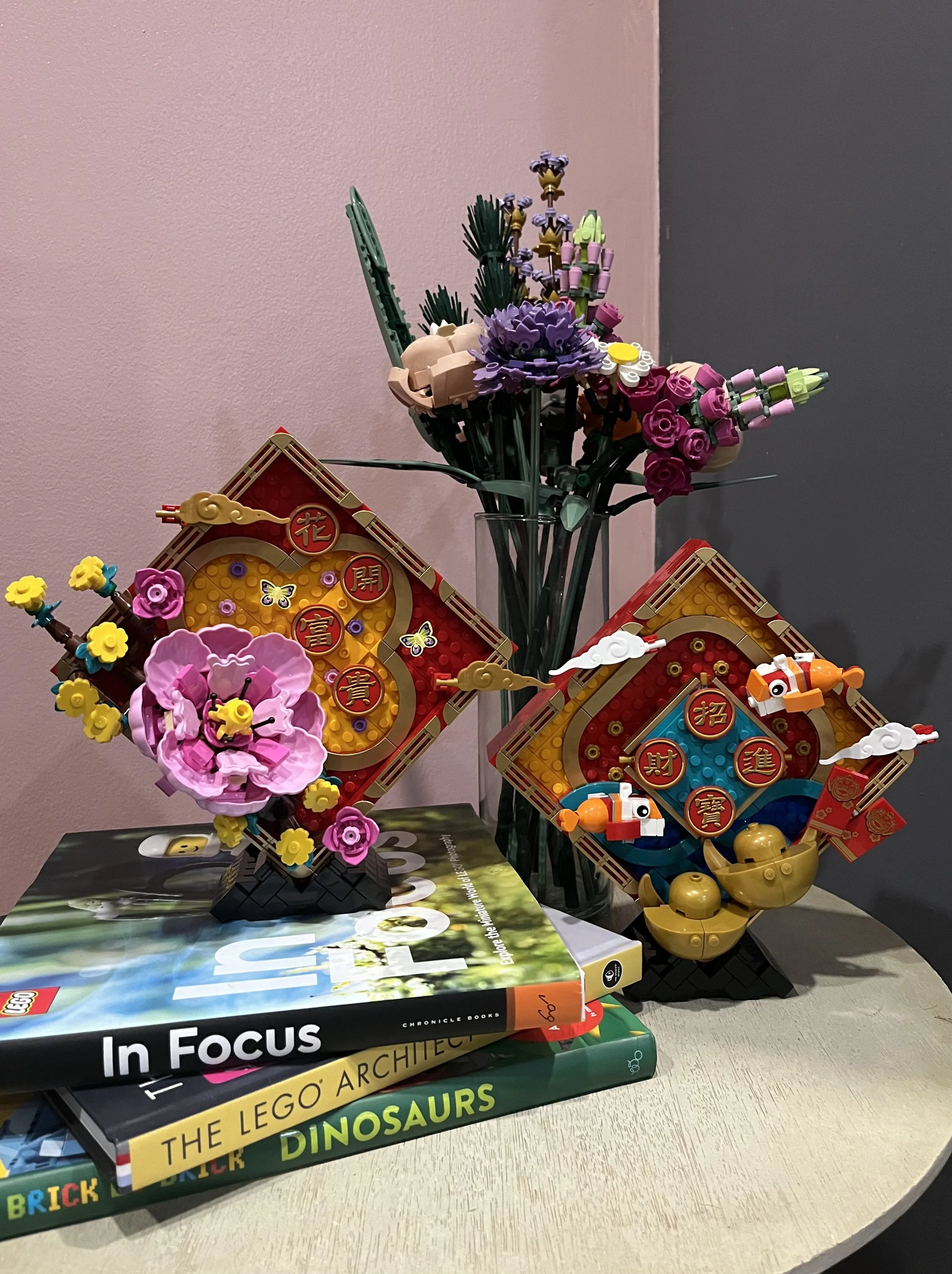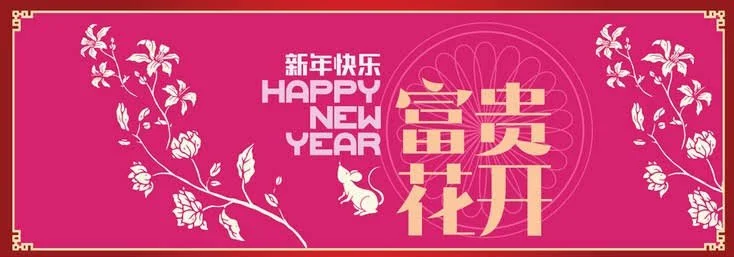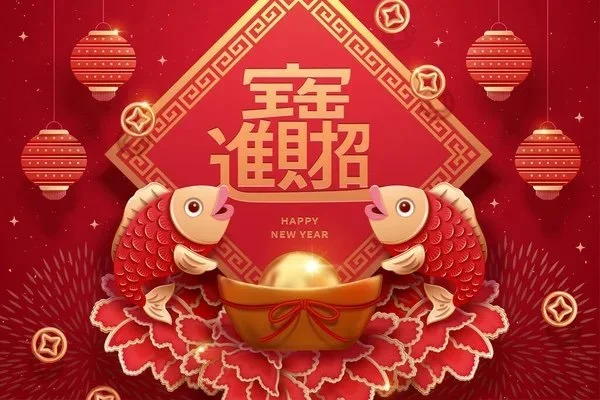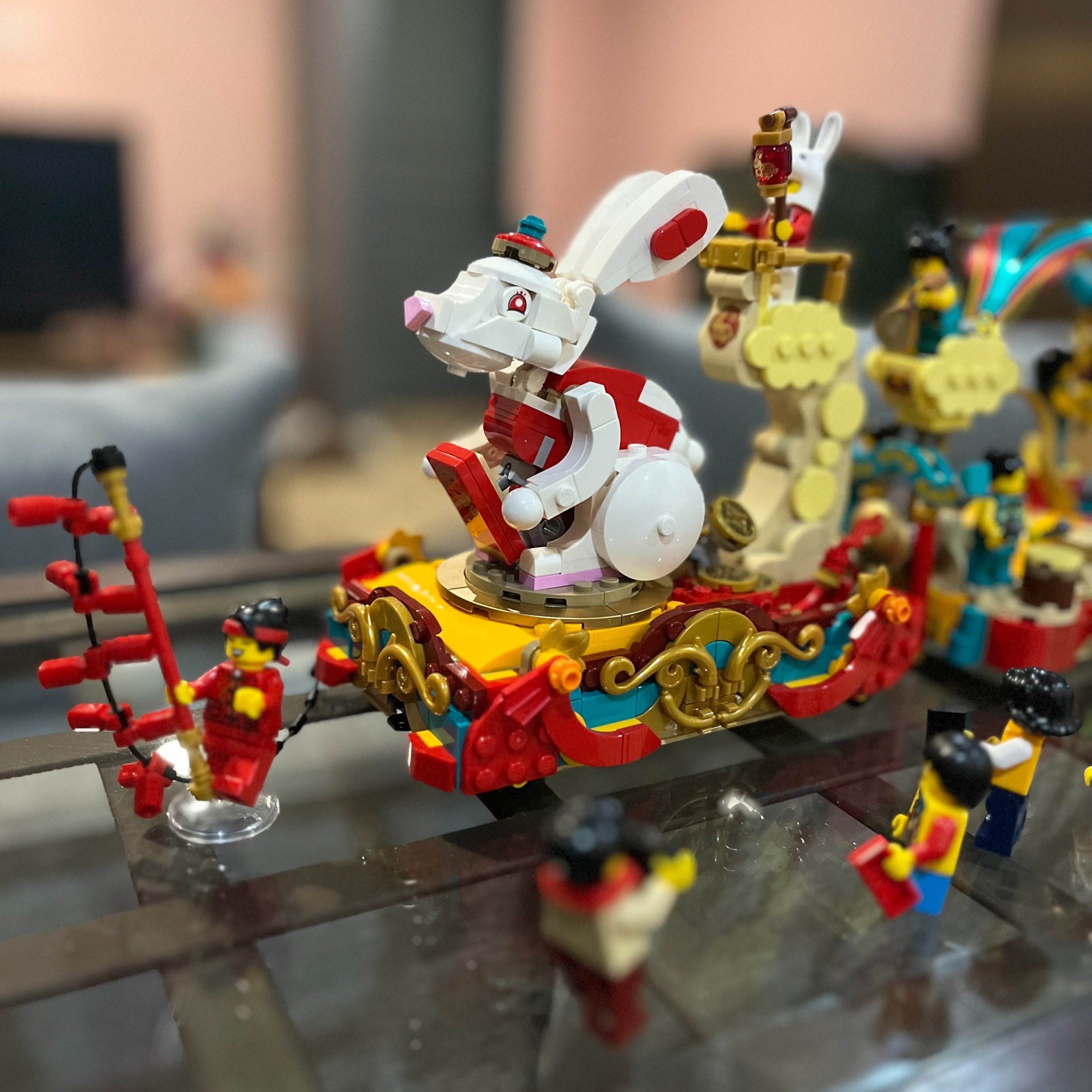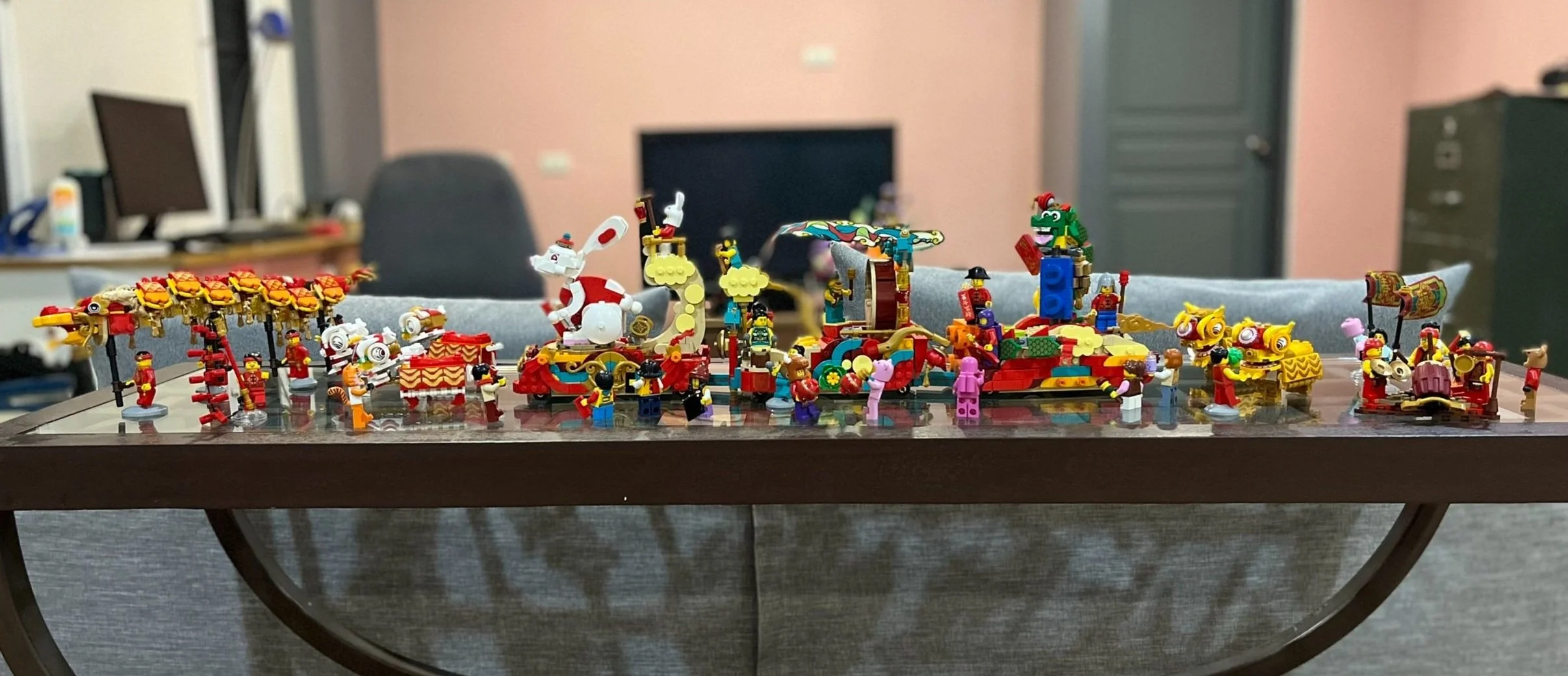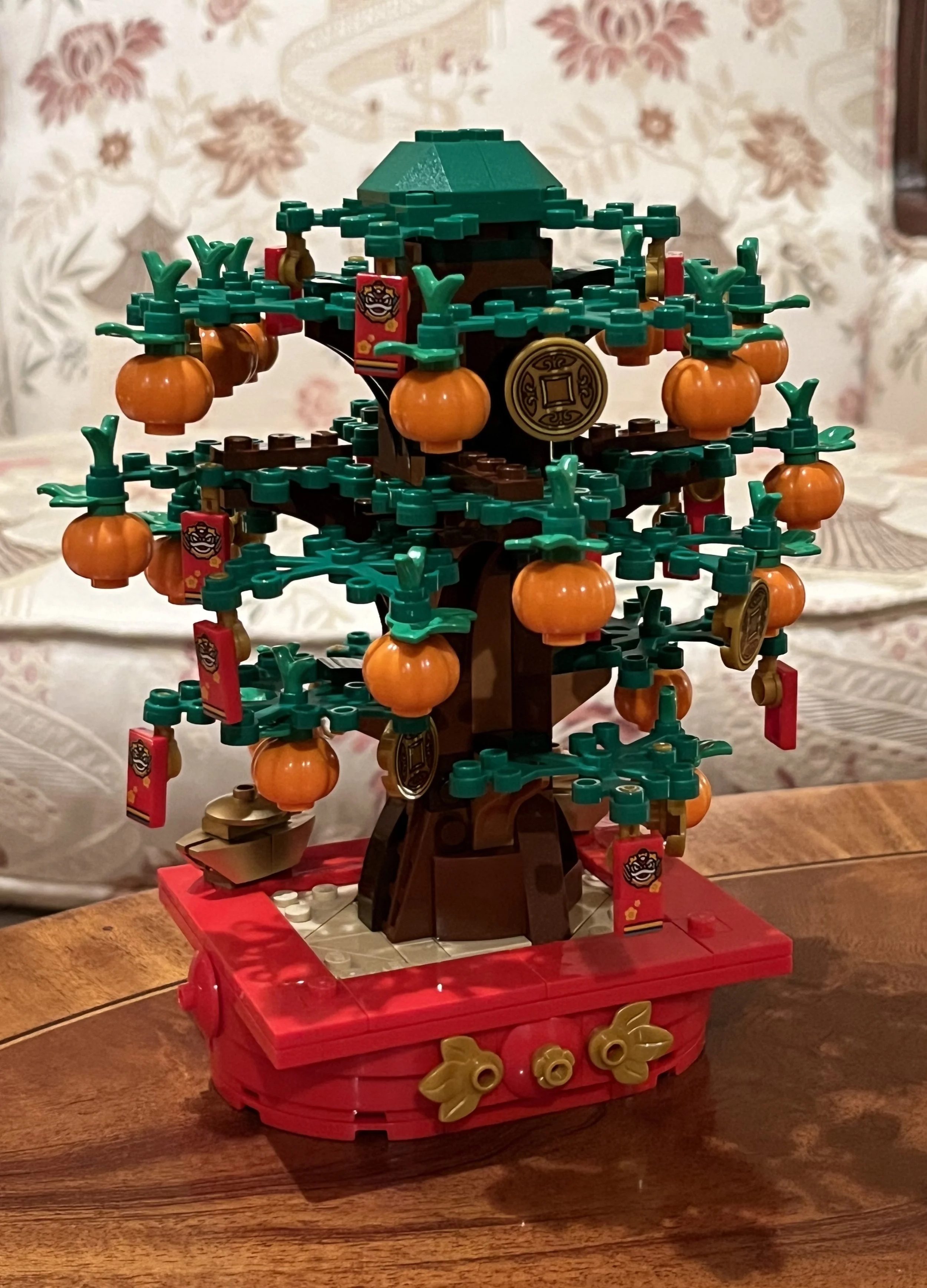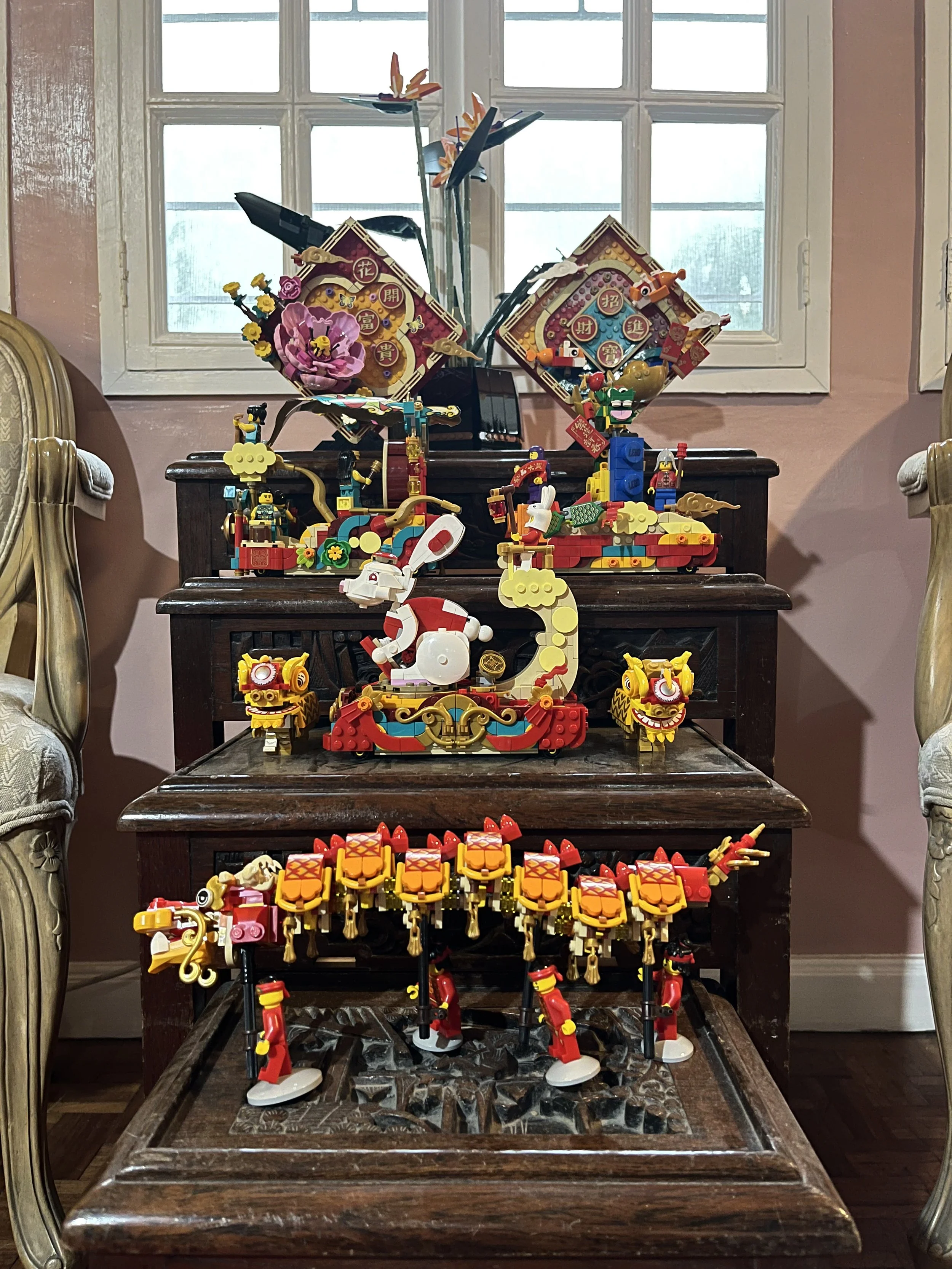Lunar New Year & LEGO: Cultural Significance and Symbolism
/The Lunar New Year, also known as the Spring Festival, is one of the most important holidays across Asia. With origins steeped in legend and folklore, it celebrates the end of winter and the beginning of spring and the new lunar calendar. While particularly important in China, it is also celebrated in countries with significant Chinese populations such as Singapore, Vietnam, Malaysia, and the Philippines. The first day of the New Year begins on the new moon that appears between 21 January and 20 February of every year, with celebrations beginning on New Year’s Eve and ending on the 15th day of the new (lunar) year.
Manuals with the Spring Festival seal.
LEGO has been producing “Chinese Festival Special Edition” sets to celebrate the Spring Festival since 2019, originally released only in the Asia Pacific region. Luckily for the rest of the world, these sets have become more widely available through the years. Given that the Chinese diaspora is global—and considering the appeal of these sets in general—making the sets available outside Asia was a wise move for LEGO. Releasing the sets to other areas has definitely showcased Chinese customs and traditions, while at the same time capturing the attention (and probably pockets) of the lucrative Chinese market.
LEGO sent us three of their latest sets, 80110 Lunar New Year Display, 80111 Lunar New Year Parade, and 40648 Money Tree, to welcome 2023. We took a closer look at the traditions and symbolisms embodied in these builds and chatted with various AFOLs around the world to gain insight into Chinese culture.
Lunar New Year Display
The Lunar New Year Display (LNY Display) puts together symbols considered lucky into one package. Such symbols are prominently displayed in homes or establishments celebrating the New Year. LEGO is marketing these sets as great presents for kids and anyone interested in Asian culture, tying it with the tradition of gift-giving during the New Year.
For easy reference, we’ve put together a list of the traditional festive symbols found in the LNY Display and the significance they have:
招財進寶 (Zhao Cai Jin Bao): Ushering in wealth and prosperity.
花开富贵 (Hua Kai Fu Gui): The richness of being in full flower.
Koi swimming: Koi are carp, which are considered symbols of wealth and power. A frequently seen image is of a carp swimming and leaping against the current of a river to reach the spawning grounds. In Chinese mythology, a carp able to leap through the Dragon Gate will become a dragon. This symbolizes the persistent effort needed to overcome obstacles (and is also the reason why Magicarp evolves into Gyarados in Pokemon).
”Yuan bao”/Gold Ingots: Symbols of wealth and prosperity, a type of gold or silver ingot currency used in imperial China.
“Hong bao”/Red Packets or Envelopes: Gifts given to children or young, unmarried adults during celebrations such as the New Year. The red color of the envelope symbolizes good luck and is a symbol to ward off evil spirits.
Clouds: Represent the heavens and good luck
Moutan Peony: Associated with longevity, loyalty, happiness and eternal beauty, the peony is immensely popular and has long been in the running to be China’s national flower (you can read about the debate on China’s National Flower here).
Butterflies: Symbol of long life, as well as joy.
While the koi are cute and the Yuan Bao are okay (props to LEGO, it’s not easy making a gold boat), the peony is a standout. It is beautifully made with light pink clamshells and the re-colored 3x3 Design Plate “splat tile” (80677). The printed butterfly piece is also noteworthy, making it one of the most intricately detailed elements ever to fit on a 1x1 stud.
Hua Kai Fu Gui image from Shutterstock.
The inspiration for these sets seems to come from greeting cards or Hangbao exchanged during the New Year. “Zhao Cai Jin Bao” and “Hua Kai Fu Gui” searches result in images of paintings, greeting cards, or red envelopes with koi swimming with gold ingots and blooming peonies or flowers, respectively. However, LEGO has created a unique piece of art that breathes life into these good luck messages.
When asked if she would display such sets in her home, Rache Go, professional photographer and co-founder of the Chinese-Filipino heritage group called Chinoylife, gave a resounding YES: “It’s LEGO! Plus it matches Chinese New Year. Why not?”
Lunar year paper art design. vector created by kchungtw, available for download here.
Lunar New Year Parade
The Lunar New Year Parade (LNY Parade) comes with three connectable, moving parade floats dedicated to the rabbit (the zodiac animal for 2023), music, and LEGO (because eh, why not?). It also has 18 minifigures, including a highly coveted purple astronaut with the helmet and tank. For a complete review of all the intricate details, do check out Jay's Brick Blog by Jay Ong, who has also thoughtfully provided translations for all the Chinese characters.
Van Chiu, Chairman/Ambassador of the Hong Kong Brick Rail LUG, commented on the LNY Parade set: “The Parade is something that we can relate to, as our city usually hosts such parades while inviting companies to create their own vehicles related to the LNY theme and promote themselves for the parade. [The set is] also quite good as it introduces movements onto each vehicle once it’s pushed along.”
The Lunar New Year Parade does take up a lot of shelf space, measuring almost 2 feet long when on display as interconnected floats.
Below are some of the cultural references and traditions found in the LNY Parade:
Firecrackers: Used to scare away evil sprits.
Gold coins: Symbolize wealth and prosperity; gold is also considered a lucky color.
Rabbit: One of the 12 animals of the Chinese Zodiac and is the designated animal for 2023. You can read the story on the origins of the Chinese Zodiac here. The rabbit symbolizes longevity because of the Taoist Legend about the hare that lives on the moon and mixes the elixir of immortality. This is the 5th Zodiac Animal in a minifigure costume that has been released so far.
Pipa: A traditional Chinese instrument often called the Chinese lute.
Music and loud noise: Symbolized by the various drums, cymbals, and instruments in the music-themed float that are meant to scare away evil spirits.
Giant Buddha Heads: Meant to bring cheer and fun to parades.
All the chinese zodiac animals as costumed minifigures since 2019.
A parade is an excellent choice for a LEGO set as parades are staged in China and in Chinese communities across the globe. For example, the Golden Dragon Parade in Los Angeles, California, will be hosting its 123rd parade this 2023! The San Francisco Parade is even older, having been started in the days of the California Gold Rush by Chinese immigrants looking for work.
big head buddha masks, carrying shiny banners with characters for “spring” and “prosperity.”
One of the more prominent New Year parades is the Chingay Parade in Singapore. The Chingay Parade was started as a way to compensate for the ban on firecrackers during Chinese New Year celebrations 50 years ago. It has since evolved into a multi-cultural event, bringing together Singapore’s Chinese, Malay, Indian, and Eurasian populations.
Jeffrey Kong, a Singapore-based artist who creates art with building bricks, talks about experiencing the parade: “The Chingay parade has been a major event in Singapore for many years. My family used to watch it on TV. It used to be held along Orchard Road, but in recent years it was also held in other places in town and beyond (the suburbs, or what we call “heartlands” in Singapore).” When asked for his thoughts about the Lunar New Year Parade, Jeffrey shared, “The set looks great! I’m not sure if the designers based it on the Chingay Parade, but they sure did a good job of capturing the mood.”
Chingay Parade By Greg Hume.
This, perhaps, is the greatest appeal of the LNY Parade. It does not identify a particular locale. Rather, the parade depicts a scene familiar to most people who celebrate the Chinese New Year. This broadens the set’s appeal beyond the Chinese market as other cultures and nationalities have likewise experienced such festivities.
This cute bunny leads the parade and nods when the float moves.
Not all countries have lavish celebrations. Some are relatively simple with music and dragon/lion dancers only. In Manila, Philippines, the celebrations are low-key. We asked for more context and Rache explained, “Ironically, the oldest Chinatown doesn’t have parades during Chinese New Year as the date wasn’t a holiday or a special non-working holiday back then. It was a “business as usual” day. But you would see lion and dragon dancers parading around and doing dances in front of establishments in exchange for a red packet. Representatives would go around in advance to ask if they want a dragon or lion dance on Chinese New Year beforehand.”
While the Parade Set is lovely on its own and based on this feedback, I added some dragon and lion dancers from previous LNY LEGO sets to give the parade a more authentic feel.
Modified parade with dragon and lion dancers from lego’s previous sets.
In my opinion, LEGO really knocked it out of the park with the LNY Parade, a set that combines intricate detail with playability... and a healthy heap of cultural references. My son has already commandeered the set and has spent many happy hours staging his parade all over the house. It is a wonderful opportunity to teach, and parents better be prepared to answer the question, “Mama/Daddy, what does this mean?” (thanks again to Jay for the translations!).
If I had one complaint, it would be that the parade set came with SO. MANY. CURVED. STICKERS. (Thankfully I’ve read BrickNerd’s Guide to Conquering the Dreaded Sticker Sheet!) Other than that though, the set is a masterpiece. The LNY Parade is definitely one of those seasonal sets that is bound to be displayed (and played with) all year long.
Money Tree
The LEGO Money Tree could well be an addition to the Botanical Collection with its green foliage and 20 cute kumquats (or kiat-kiat... or pretty much any other orange citrus fruit you like). Rache explains the significance of the money tree to Chinese-Filipino culture: “The Cantonese translation of its name, ‘Gam gat’, literally translates into gold and luck respectively. As such, it is believed by many Chinese to be an auspicious plant which symbolizes wealth and prosperity. Hence in the Philippines, the ethnic Chinese and Chinese-Filipinos still believe this.”
The Festive Money Tree is replete with good luck symbols.
Jeffrey also shared an interesting tradition featuring mandarin oranges: “Beyond the usual significance of good fortune and abundance that these items represent, the mandarin orange is what people use to wish each other good fortune (hold two oranges with both hands), and the pineapple is a popular symbol of fortune throughout the year (it is common practice to roll one across the floor of a new home or office). The names of both also sound auspicious in the respective dialects of many local Chinese people whose forebearers hail mainly from southern China.”
In addition to the tree itself, the LEGO set also showcases traditional symbols for luck such as the Yuan Bao, Hongbao, and gold coins interspersed among the leaves. You may want to remove one or two of the kumquats though, as 20 is not a particularly auspicious number for the Chinese. If you believe in luck, then this tree is for you. And if you don’t, at the very least you’ve got a very interesting conversation piece when friends come over.
The Future of LNY Sets
With only five out of the 12 Zodiac animals out in minifigure form, it is safe to assume that LEGO will probably (hopefully!) have another seven years of this theme. Van comments on the surprising staying power of the product line, ”I didn't imagine LNY sets could contain such broad concepts and ideas, and thus the ability to maintain this product line for five years already. I do think LEGO will want to keep having 12 years of the Zodiac, while I hope LEGO will continue and improve from the older Zodiacs after the first 12 years.” Van also expressed a wish for the future of the LNY sets: “Using these LNY sets to hit the Chinese market, perhaps there are other possibilities to include various cultures and their special occasions as future sets.”
LEGO has also produced limited Chinese Zodian Gift with Purchase sets as seen here via Richard at Rambling Brick.
Through the LNY sets, LEGO users are introduced to various aspects of Asian culture. On LEGO’s actions of sharing Asian culture with the rest of the world, Rache says: “It’s a good thing. Because most kids aren’t interested in learning about heritage and culture. Toys like LEGO are a good avenue to know more about it.”
Jeffrey agrees: “Producing sets of a major festival celebrated by one-fifth of humanity is great for representation (and makes perfect sense to tap into such a big market). I look forward to more sets where the builder can learn something about other cultures. Granted, this is easier said than done due to the need to balance sensitivity (many festivals are religious, so cultural appropriation and so on), but looking at what LEGO has been doing with #EveryoneIsAwesome and their new inclusive Friends characters, we have reason for hope.”
LEGO is increasingly embracing the diversity of its market and clientele. As it continues to promote diversity and inclusion, not only in corporate practices but in its actual products, here’s hoping that LEGO users the world over also learn to embrace diversity and inclusion and perhaps, truly, build a better world.
My home is ready for the Lunar new year! gong xi fa cai!
DISCLAIMER: These sets were provided to BrickNerd by LEGO. Any opinions expressed in this article are those of the author and the interviewees.
Do you celebrate the Lunar New Year? What do you think of LEGO’s LNY sets? Let us know in the comments!
Do you want to help BrickNerd continue publishing articles like this one? Become a top patron like Charlie Stephens, Marc & Liz Puleo, Paige Mueller, Rob Klingberg from Brickstuff, John & Joshua Hanlon from Beyond the Brick, Megan Lum, Andy Price, John A. and Lukas Kurth from StoneWars to show your support, get early access, exclusive swag and more.


